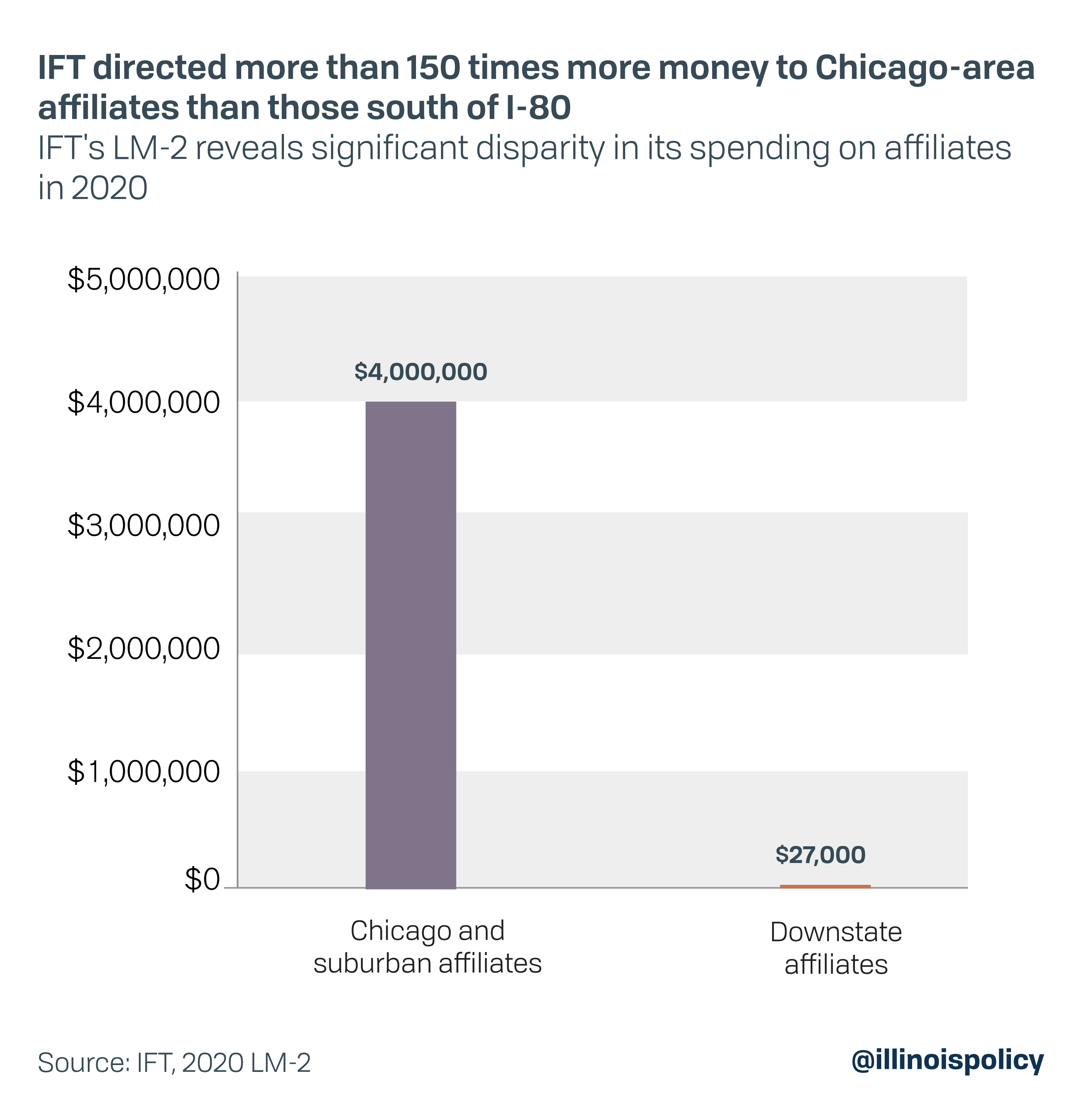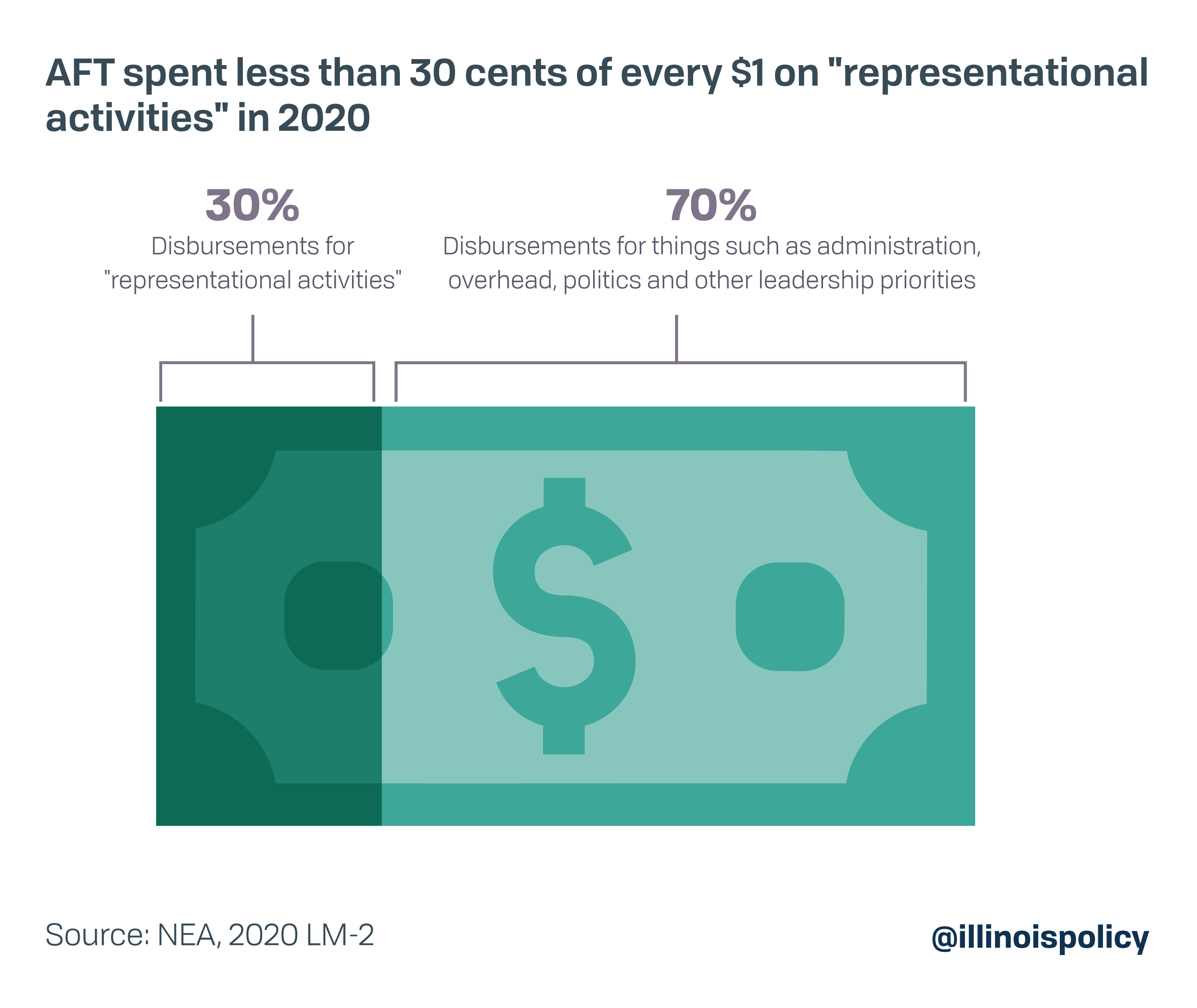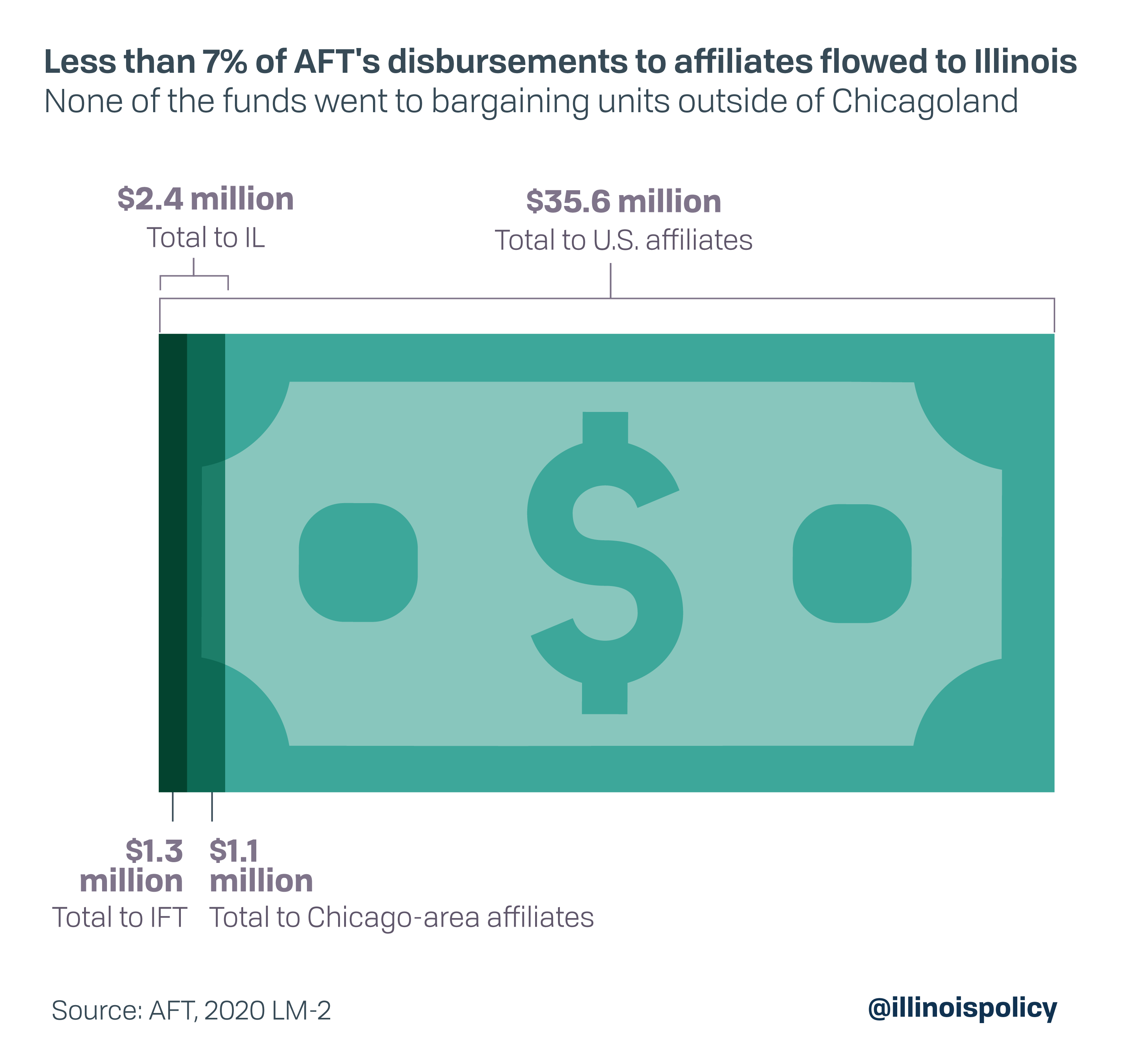Illinois educators pay hundreds of dollars every year in dues to their unions.
The bulk of that money doesn’t stay with the local bargaining units. It flows up the chain to the state and national affiliates.
Teachers have a right to know how those affiliates are spending money. The best public sources for examining union spending are LM-2s, which are federal reports unions file annually with the U.S. Department of Labor.1
LM-2s provide information, in the union’s own words, about how the union spends money. These reports can be difficult to access or interpret.2
To assist teachers in evaluating the spending of the Illinois Federation of Teachers and the American Federation of Teachers, this report examines data pulled from the unions’ LM-2s on the following areas of spending:
- Representational spending
- Spending on affiliates
- Questionable spending
Illinois Federation of Teachers
The Illinois Federation of Teachers spent over $44 million in 2020.3
All members of local IFT bargaining units are also members of and send money to the state affiliate. As such, they have a right to know how IFT prioritized spending in 2020.
Representational spending: Only 23% of IFT’s spending in 2020 was on representing members
IFT reported spending just $10,394,310 on “representational activities4 – those activities related to negotiating collective bargaining agreements and the administration and enforcement of those agreements5 – in 2020.
That means only 23% of IFT’s total spending was directed toward representing its members.
IFT spent the rest on administration, overhead, politics and other leadership priorities.
To place this in perspective, the Wise Giving Alliance, a project of the Better Business Bureau, maintains a nonprofit should spend at least 65% of its total expenses on program activities.6
While the Wise Giving Alliance tracks spending by charities, it stands to reason that IFT’s spending of 23% on representation – the purpose of a union – should be a cause for concern among members.
Spending on affiliates: IFT spent 150 times more on Chicagoland affiliates than it did on affiliates south of Interstate-80
IFT represents educators throughout Illinois.
Yet, the union clearly favors its affiliates in and around Chicago when it comes to funding.
IFT directed over $4 million to affiliates in Chicago and Chicago suburbs in 2020, with three-quarters of that money flowing to the Chicago Teachers Union.7 It directed less than $27,000 to its affiliates south of Interstate 80.8
There also is a disparity between IFT’s spending on other northern Illinois affiliates and Chicago-area affiliates. The union sent nearly seven times more money to Chicagoland affiliates than it did to other affiliates in northern Illinois.9
While educators all over Illinois sent thousands of dollars up the chain to IFT, they saw the vast majority of IFT’s affiliate spending flow to Chicagoland.
Questionable spending: IFT prioritized politics and leadership
IFT’s 2020 LM-2 reveals the union’s priorities extended to spending money on politics and on its own officers and employees.
Politics
Many union members believe a longstanding myth that membership dues don’t fund politics, but IFT admitted spending over $922,000 on political activities and lobbying in 2020.10 That included nearly $62,000 on the failed progressive tax ballot measure.11
It also spent nearly $3,800 in contributions, gifts and grants, which can be political in nature.12 Notably, none of the disbursements were itemized, meaning members have no way of knowing where the money was contributed.
Leadership
IFT also prioritized spending on its own leaders. The union reported spending over $10.6 million for officer and employee salaries in 2020.13 Most of that money was spent for purposes other than representing members.14
What’s more, the top 10 earners at IFT received salaries from the affiliate over $197,000 in 2020, with nine of the 10 clearing $200,000.15
On the other hand, the average public school teacher in Illinois made just over $68,000 in 2019-2020.16
American Federation of Teachers
The American Federation of Teachers spent over $238 million in 2020.17
But its priorities may not reflect how teachers would want their dues money spent.
Representational spending: Less than 30% of AFT’s spending in 2020 was on representing members
AFT reported it spent just $71,108,444 on representational activities – those activities supposed to be its core purpose – in 2020.18
That means just 30 cents of every dollar AFT spent in 2020 went toward activities supporting the representation of its members.
AFT spent the rest on things such as administration, overhead, politics and other leadership priorities.
AFT’s spending on representation was down in 2020. In fact, it was the lowest the union had spent on representational activities since 2013.19
And, as previously mentioned, the Wise Giving Alliance maintains at least 65% of a nonprofit’s total expenses should be on program activities.20 AFT’s representational spending falls far short and should be a cause for concern among members.
Spending on affiliates: Less than 7% of funds AFT disbursed to its affiliates went to Illinois-based affiliates
AFT disbursed over $35.6 million to its affiliates in 2020.21
Yet just $2.4 million – 7% of the total – went to Illinois-based affiliates, with Chicago affiliates getting over $1.1 million of that amount.22
The rest went to IFT and its political action committee, with non-Chicago bargaining units receiving nothing from AFT.23 And as demonstrated above, IFT doesn’t have a track record of prioritizing disbursements to non-Chicago affiliates.
While Illinois educators send thousands of dollars up the chain to AFT each year, AFT in turn sent money all over the country.
Questionable spending: AFT spent millions on leadership, politics and unexplained travel costs
AFT’s LM-2 revealed the union’s priorities extended to spending on its own salaries, politics and unexplained travel expenses.
Leadership
First, AFT reported it spent nearly $45 million for officer and employee salaries in 2020.21 The top 10 earners made over $231,000 a year, with AFT President Randi Weingarten taking in over $450,000, according to the union’s LM-2.22
But what is reported in an LM-2 only marks a portion of Weingarten’s total compensation. For example, the union’s 990 for the fiscal year ending June 30, 2019, reported her receiving over a half million dollars from the union and “related organizations.”23
Politics
In addition, AFT reported spending over $31 million on “political activities and lobbying” in 2020.24
It spent another $8.4 million on other “contributions, gifts and grants,” which can be political in nature.25
Examples of AFT’s political spending and contributions in 2020 include the following:
- Over $3.2 million to self-proclaimed “progressive” organizations26
- Over $416,000 to individual candidates.27
Members have little to no say over the political causes funded by the union.
Unexplained travel costs
AFT spent millions on travel, most of which was not itemized in the LM-2 or itemized so generically that it provided no real accountability to members on how or why the money was spent.
Examples include the following:
- Over $2.2 million to airlines (either non-itemized or itemized generically as “transportation”)28
- Over $623,000 to hotels (either non-itemized or itemized generically as “hotel expense”), including international hotel expenses29
- Over $224,000 on other transportation, such as car rentals and trains (non-itemized or itemized generically as “transportation”)30
- Over $61,000 to a travel agency (either non-itemized or listed as “travel administrative fee”).31
Again, because these disbursements were not explained, members have no way to evaluate their validity or hold the union accountable for its spending.
Conclusion
IFT’s and AFT’s LM-2 forms – the federal reports unions file, using their own accounting – shed light on the patterns, practices and priorities of union leadership.
For many teachers, seeing how IFT and AFT spend money is disheartening.
But Illinois educators who want more control over their dues money have options:
- Teachers can get liability insurance and legal protection elsewhere. Educators can join other associations, such as the Association of American Educators. AAE, which has 25,000 members across the country, provides liability insurance and legal protection to public school employees – typically at a fraction of the cost of union membership.
- Teachers can opt out of union membership and keep all employer-provided benefits. By opting out of union membership, a teacher stops paying dues to the union yet retains all benefits that are provided in the collective bargaining agreement with the school district.
Opting out doesn’t mean educators don’t support their local bargaining unit. In fact, educators are free to send voluntary donations to their local bargaining units without being members – thereby helping ensure their support stays local.
For more information, visit LeaveIFT.com.
Endnotes
1Only unions that represent private employees, U.S. Postal Service employees or most federal government employees are subject to reporting requirements under the Labor-Management Reporting and Disclosure Act of 1959 and the Civil Service Reform Act of 1978. United States Department of Labor, “Reports required under the LMRDA and the CSRA.” The Illinois Federation of Teachers and American Federation of Teachers must file the LM-2 reports because they take in $250,000 or more a year and represent some workers in the private sector.
2LM-2s are not without flaws. Unions are given great discretion in how they categorize spending. What’s more, unions do not have to itemize spending that falls below $5,000. See United States Department of Labor, “Instructions for form LM-2 labor organization annual report,” revised March 2020. Yet, LM-2s provide insight into union spending because they provide a look into the union’s own accounting.]
3Illinois Federation of Teachers, 2020 LM-2, Statement B – Receipts and disbursements (reporting $44,330,092 in total disbursements).
4Illinois Federation of Teachers, 2020 LM-2, Statement B – Receipts and disbursements (reporting $10,394,310 in spending on “representational activities”).
5These activities are defined by the U.S. Department of Labor as “the labor organization’s direct and indirect disbursements to all entities and individuals during the reporting period associated with preparation for, and participation in, the negotiation of collective bargaining agreements and the administration and enforcement of the agreements made by the labor organization.” United States Department of Labor, “Instructions for form LM-2 labor organization annual report,” revised March 2020. It also includes activities related to organizing a unit or warding off a decertification.
6Better Business Bureau, “BBB Standards for charity accountability,” 2020.
7Illinois Federation of Teachers, 2020 LM-2, Schedules 15-19 (reporting $4,004,080 in disbursements to affiliates in Chicago and Chicago suburbs, with $3,058,793 going to the Chicago Teachers Union).
8Illinois Federation of Teachers, 2020 LM-2, Schedules 15-19 (reporting $26,689 in disbursements to affiliates south of Interstate 80).
9Illinois Federation of Teachers, 2020 LM-2, Schedules 15-19 (reporting $578,517 in disbursements to affiliates in northern Illinois outside of Chicagoland).
10Illinois Federation of Teachers, 2020 LM-2, Statement B – Receipts and disbursements (reporting $922,385 on “political activities and lobbying”).
11Illinois Federation of Teachers, 2020 LM-2, Schedule 16 (reporting $61,947 on “fair tax campaign”).
12Illinois Federation of Teachers, 2020 LM-2, Statement B – Receipts and disbursements (reporting $3,800 on “contributions, gifts, and grants”).
13Illinois Federation of Teachers, 2020 LM-2, Schedules 11 and 12 (reporting $10,645,467 on officer and employee salaries).
14Unions filing LM-2 forms are required to designate how much of officer and employees’ salaries are for what purpose, making it simple to calculate how much unions spend on salaries for purposes other than representing members. See Illinois Federation of Teachers, 2020 LM-2, Detailed summary page – Schedules 14 through 19 (reporting just $4,975,254 on officers and employees for representational activities).
15Illinois Federation of Teachers, 2020 LM-2 Schedules 11 and 12.
16Illinois State Board of Education, “Illinois Report Card: State Snapshot” (2020).
17American Federation of Teachers, 2020 LM-2, Statement B – Receipts and disbursements (reporting $238,479,145 in total disbursements).
18American Federation of Teachers, 2020 LM-2, Statement B – Receipts and disbursements (reporting $71,108,444 on “representational activities”).
19See American Federation of Teachers, 2019 LM-2, Statement B – Receipts and disbursements (reporting $73,912,907 on “representational activities”); American Federation of Teachers, 2018 LM-2, Statement B – Receipts and disbursements (reporting $76,103,716 on “representational activities”); American Federation of Teachers, 2017 LM-2, Statement B – Receipts and disbursements (reporting $75,235,673 on “representational activities”); American Federation of Teachers, 2016 LM-2, Statement B – Receipts and disbursements (reporting $77,641,055 on “representational activities”); American Federation of Teachers, 2015 LM-2, Statement B – Receipts and disbursements (reporting $73,786,000 on “representational activities”); American Federation of Teachers, 2014 LM-2, Statement B – Receipts and disbursements (reporting $72,554,531 on “representational activities”); American Federation of Teachers, 2013 LM-2, Statement B – Receipts and disbursements (reporting $68,136,270 on “representational activities”).
20Better Business Bureau, “BBB Standards for charity accountability,” 2020.
21American Federation of Teachers, 2020 LM-2, Schedules 11 and 12 (reporting $44,802,945 on officer and employee salaries).
22American Federation of Teachers, 2020 LM-2, Schedules 11 and 12.
23American Federation of Teachers, 990 (2019 reporting year) (reporting $489,844 in compensation and $74,392 in additional compensation from the union and related organizations).]
24American Federation of Teachers, 2020 LM-2, Statement B – Receipts and disbursements (reporting $31,266,948 on “political activities and lobbying”).
25American Federation of Teachers, 2020 LM-2, Statement B – Receipts and disbursements (reporting $8,477,436 on “contributions, gifts, and grants”).
26American Federation of Teachers, 2020 LM-2, Schedules 15-19 (reporting $3,262,000 to organizations that publicly proclaim or advocate “progressive” causes).
27American Federation of Teachers, 2020 LM-2, Schedules 15-19 (reporting $416,803 to individual candidates).
28American Federation of Teachers, 2020 LM-2, Schedules 15-19 (reporting $2,270,286 to airlines).
29American Federation of Teachers, 2020 LM-2, Schedules 15-19 (reporting $623,877 to hotels).
30American Federation of Teachers, 2020 LM-2, Schedules 15-19 (reporting $224,361 for car rentals, trains and “transportation”).
31American Federation of Teachers, 2020 LM-2, Schedules 15-19 (reporting $61,621



